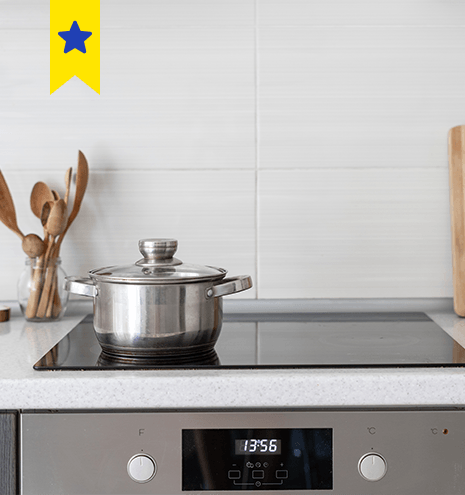November 18, 2022

How to Clean Glass Stovetops
Many modern kitchens feature a stove with a glass cooktop. They are popular for their smooth and glossy appearance, making a kitchen feel clean, fresh, and contemporary. You can use the glass stovetop for extra counter space when the burners aren’t on or hot. Additionally, they are easy to clean since they don’t have grates, like electric or gas stoves do.
Grease, burned-on food, spills, and other grime can stick to the stovetop. Cleaning the stovetop daily can prevent build-up and make it easier to do an occasional deep clean. This guide will explain how to clean your glass stovetop, so it looks shiny and new. Check out this guide if you want to know how to clean your oven.
The Importance of Cleaning Your Glass Stovetop
Glass cooktops require different care than electric or gas ranges. Since the top is a ceramic-glass blend, it can scratch more easily than others. The stovetop is also prone to streaking, causing it to appear less clean than it is. Therefore, it’s important to clean your cooktop regularly.
Regularly cleaning your stovetop can prevent cooking residue from accumulating and becoming burned-on stains. Burned-on stains are tougher to remove and can smell when the stove is hot. Routine cleaning also helps prevent streaks.
What to Avoid Putting on Your Glass Stovetop
While it’s possible to clean a conventional stove with almost anything, the same is not true for glass cooktops. Here’s a list of items to avoid placing on your stovetop:
Glass cleaner: It might seem like a good idea to use a glass cleaner to clean the stovetop, but it isn’t. Most glass cleaners contain ammonia, a chemical that is too harsh for your glass-top stove. Using it can leave streaks and stains that are nearly impossible to remove.
Spills: Spills are unavoidable, but it’s best to remove them as soon as possible. Allowing spills to sit on your stovetop makes them harder to remove.
Heavy pots: Avoid using ceramic, cast iron, and stoneware on glass tops. These pots and pans are heavy and rough and could scratch your stove’s surface. If you must use them, ensure you set them down gently and avoid dragging them across the stovetop.
Utensils: Any cooking utensils on your glass top could melt, leaving a burned-on mess or scratching the surface. To avoid this, use a spoon rest on your countertop to hold your utensils.
How to Clean Daily Messes
The best way to avoid tough stains and messes is to make cleaning part of your daily routine and clean your cooktop after every use. Cleaning spills and stains before they have a chance to stick saves you time and scrubbing.
What You’ll Need
Before you can clean your stovetop, you must gather a few supplies. These include:
White vinegar
Spray bottle
Microfiber cloths
Sponge
Grease-cutting spray or wipe for glass-top stoves
Steps for Cleaning Everyday Messes
Here are the steps to cleaning your stovetop daily:
Wipe up spills on the stovetop: Use a damp sponge or microfiber cloth to wipe away spills and splatters as they occur. This prevents the spills from accumulating and becoming tougher to remove.
Spray the stovetop: Fill the spray bottle with a mixture of vinegar and water. Spray the mixture onto the stovetop and wipe it with a damp microfiber cloth.
Dry and polish the stovetop: Use a dry microfiber cloth to dry the glass cooktop and remove any streaks. It will also buff the surface and make it glossy.
If you have grease stains, use a grease-cutting spray or wipe that’s safe for glass stovetops instead of vinegar. It won’t leave streaks and can take care of tougher stains quickly.
How to Clean Heavy Messes
Sometimes, life gets busy, and cleaning up all the little spills and splatters becomes challenging. If the deposits on your stovetop have become stuck, you must use a different method to clean it.
What You’ll Need
To clean tougher stains, you’ll need the following:
Glass cooktop cleaner cream or paste
Non-abrasive scrubbing pad
Baking soda
Microfiber cloths
Paper towels
Steps for Cleaning Heavy Messes
Here are the steps for removing heavy deposits on your glass stovetop:
Apply cooktop cleaner onto the stovetop: Apply the paste or cream cleaner and spread it around the surface. Use circular motions and a non-abrasive sponge to spread it.
Sprinkle baking soda onto the stovetop: To remove tougher stains, sprinkle baking soda onto the surface and scrub with a damp cloth. Then, rinse and dry it. The baking soda should help polish the surface and make it shine.
Rinse and dry the stovetop: You want to ensure you remove any product residue so it doesn’t bake, burn on, or interfere with your stovetop’s functionality. Wipe everything down with a damp microfiber cloth until there’s no residue. Once you have wiped it down, dry the surface with a dry microfiber cloth or paper towel.
How to Clean Burned-On Messes
If your glass cooktop has burned-on grime, it requires deeper cleaning and different tools.
What You’ll Need
To remove burned-on messes, you’ll need the following:
Razor blade
Hot, damp towel
Glass cooktop cleanser
Microfiber cloths
Paper towels
Steps for Cleaning Burned-On Messes
The steps for cleaning burned-on messes are as follows:
Place a hot towel on the stovetop: Lay the hot, damp towel on the stovetop for a few minutes to soften the residue.
Use a razor blade on the stovetop: While holding the razor blade at a 45-degree angle, carefully scrape off the burned residue. Depending on how severe the messes are burned-on, you may have to repeat the first two steps several times. The glass on the stovetop is durable and should be able to withstand scraping with a sharp razor blade.
Clean the stovetop: Follow the steps for cleaning heavy messes.
Cleaning Tips
Here are general cleaning tips to help you keep your stovetop in tip-top shape:
Let the surface cool: Ensure the stove’s surface is off and cool to the touch before cleaning it. If you clean the stovetop while it is hot, you could burn yourself, ruin your sponge or cloth, or create streaks.
Ensure your cleaners are safe for glass-top stoves: Some cleaners may contain chemicals that could scratch your stovetop so you want to ensure the cleaners you use are for glass-top stoves.
Use gentle tools: You must use a non-abrasive sponge on your cooktop, or you risk scratching the surface. Avoid steel wool, scrub brushes and scouring pads.
Schedule Your Cleaning Today
To prevent tougher residue, we recommend cleaning your stovetop daily. However, life has a way of taking over. Some days it can take all your energy to make dinner. This is where we can help. Maid Bright offers recurring cleaning services in the DC Metro area. You can add special deep cleanings to your service, including stovetop cleaning. We make your satisfaction our priority.
If you have never had professional cleaning services, check out our guide on what to expect your first time. Schedule your cleaning service or free inspection online today.
Share on Social

Book Your First Cleaning
We have high standards for your home.
